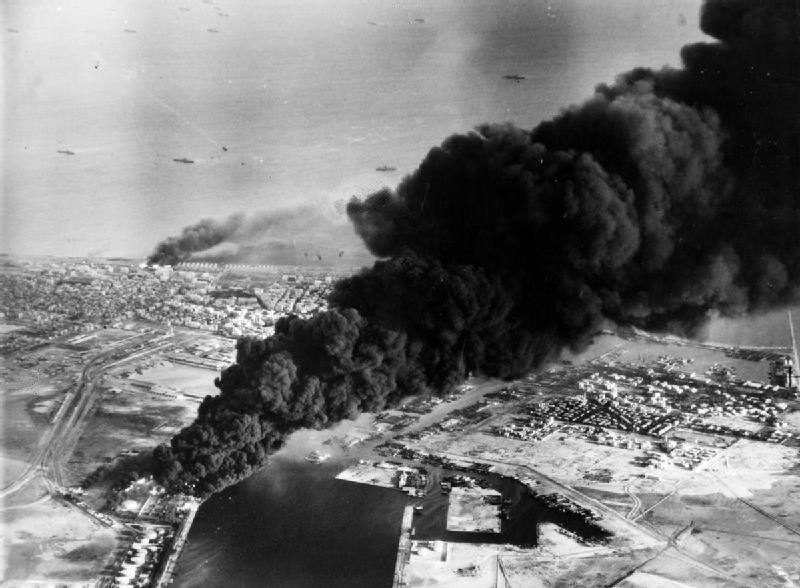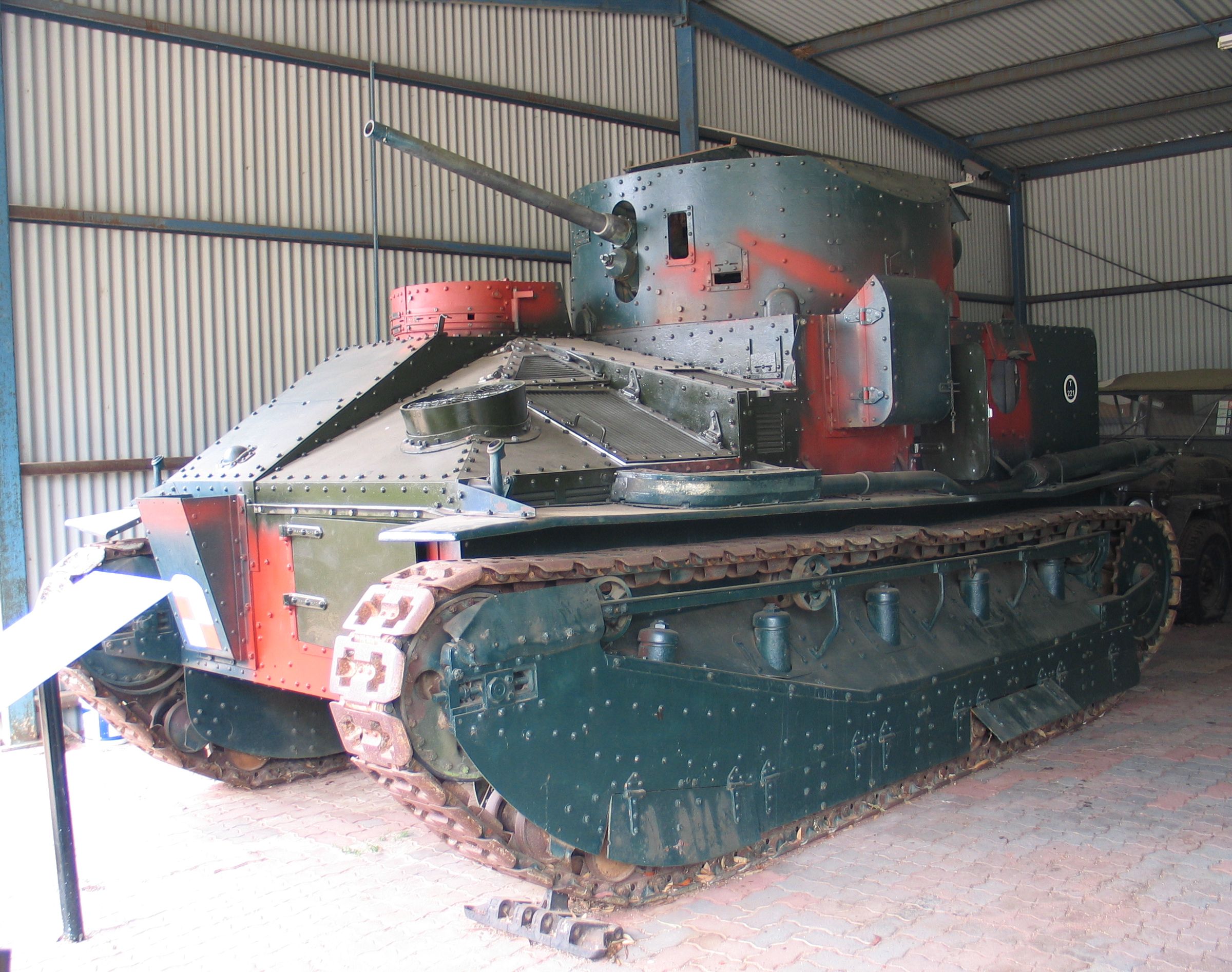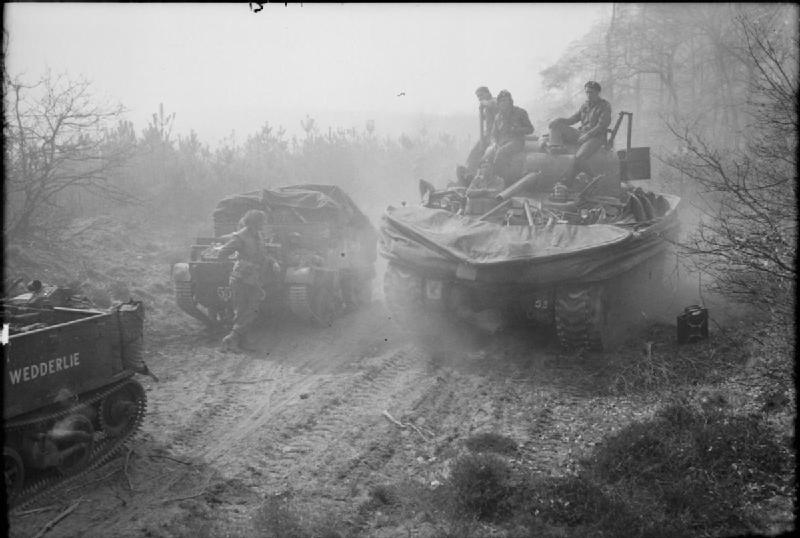|
6th Royal Tank Regiment
The 6th Royal Tank Regiment (6 RTR) was a regiment of the Royal Tank Regiment, of the British Army, until 1959. It originally saw action as 6th Battalion Tank Corps in 1917. First World War When tanks were first used in action in 1916, they were operated by the Heavy Branch of the Machine Gun Corps. This constituted six companies, A through F. With the rapid growth of the tank forces, these companies were used as the cadre of new battalions, which were quickly transferred to the newly formed Tank Corps, and then changed from letters to numbers. F Company thus became F Battalion of the Heavy Branch in November 1916, then F Battalion of the Tank Corps, then redesignated as 6th Battalion of the Tank Corps in January 1918. During this time, the unit saw heavy action; it fought at the Battle of Messines, Passchendaele, Cambrai, Amiens (using Whippet Mk A light tanks), Bapaume, 2nd Arras and Cambrai-St Quentin. During this time, a Victoria Cross was awarded to Captain Richard A ... [...More Info...] [...Related Items...] OR: [Wikipedia] [Google] [Baidu] |
WW1 Tank Mark II, Bovington
World War I (28 July 1914 11 November 1918), often abbreviated as WWI, was one of the deadliest global conflicts in history. Belligerents included much of Europe, the Russian Empire, the United States, and the Ottoman Empire, with fighting occurring throughout Europe, the Middle East, Africa, the Pacific, and parts of Asia. An estimated 9 million soldiers were killed in combat, plus another 23 million wounded, while 5 million civilians died as a result of military action, hunger, and disease. Millions more died in genocides within the Ottoman Empire and in the 1918 influenza pandemic, which was exacerbated by the movement of combatants during the war. Prior to 1914, the European great powers were divided between the Triple Entente (comprising France, Russia, and Britain) and the Triple Alliance (containing Germany, Austria-Hungary, and Italy). Tensions in the Balkans came to a head on 28 June 1914, following the assassination of Archduke Franz Ferdina ... [...More Info...] [...Related Items...] OR: [Wikipedia] [Google] [Baidu] |
North Irish Horse
The North Irish Horse was a yeomanry unit of the British Territorial Army raised in the northern counties of Ireland in the aftermath of the Second Boer War. Raised and patronised by the nobility from its inception to the present day, it was one of the first non-regular units to be deployed to France and the Low Countries with the British Expeditionary Force in 1914 during World War I and fought with distinction both as mounted troops and later as a cyclist regiment, achieving eighteen battle honours. The regiment was reduced to a single man in the inter war years and re-raised for World War II, when it achieved its greatest distinctions in the North African and Italian campaigns. Reduced again after the Cold War, the regiment's name still exists in B (North Irish Horse) Squadron, the Scottish and North Irish Yeomanry and 40 (North Irish Horse) Signal Squadron, part of 32 Signal Regiment. History Background The raising of Militia units in Ireland commenced with the "Militi ... [...More Info...] [...Related Items...] OR: [Wikipedia] [Google] [Baidu] |
Scofton, Nottinghamshire
Scofton is a hamlet in the Bassetlaw district of northern Nottinghamshire, England. It is north west of London, north of the county town and city of Nottingham, and east of the nearest town Worksop. Having a shared modern history with nearby Osberton Hall, it is sometimes referred to as Scofton-with-Osberton. Other close neighbours are Bilby and Rayton which also have historical associations. Toponymy Scofton was recorded in the Domesday Book of 1086 as ''Scotebi'', of Norse origin, possibly meaning Skopti'' 's farm'. The Old English form is ''Skofton,'' as recorded in county assize records of 1280, eventually becoming its modern form from 1316 onwards. Osberton was also listed in Domesday, and is believed to mean 'the farmstead of Osbeorn'. Bilby was ''Bilebi'' in Domesday and was a named for a person, ''Bil''. Rayton was at the time of Domesday, ''Rolvetune'' and ''Rouuetone'', which may have meant ' reeve farm', or was possibly a derivative of the nearby river. Ge ... [...More Info...] [...Related Items...] OR: [Wikipedia] [Google] [Baidu] |
Operation Musketeer (1956)
Operation Musketeer (french: Opération Mousquetaire) was the Anglo-French plan for the invasion of the Suez canal zone to capture the Suez Canal during the Suez Crisis in 1956. The operation had initially been given the codename Operation Hamilcar, but this name was quickly dropped when it was found that the British were painting an air recognition letter H on their vehicles, while the French, who spelled Hamilcar differently, were painting an A. Musketeer was chosen as a replacement because it started with M in both languages. Israel, which invaded the Sinai peninsula, had the additional objectives of opening the Straits of Tiran and halting fedayeen incursions into Israel. The Anglo-French military operation was originally planned for early September, but the necessity of coordination with Israel delayed it until early November. However, on 10 September British and French politicians and Chiefs of the General Staff agreed to adopt General Charles Keightley's alterations to t ... [...More Info...] [...Related Items...] OR: [Wikipedia] [Google] [Baidu] |
Suez Crisis
The Suez Crisis, or the Second Arab–Israeli war, also called the Tripartite Aggression ( ar, العدوان الثلاثي, Al-ʿUdwān aṯ-Ṯulāṯiyy) in the Arab world and the Sinai War in Israel,Also known as the Suez War or 1956 War; other names include the ''Sinai war'', ''Suez–Sinai war'', ''1956 Arab–Israeli war'', the Second Arab–Israeli war, ''Suez Campaign'', ''Sinai Campaign'', ''Kadesh Operation'' and ''Operation Musketeer'' was an invasion of Egypt in late 1956 by Israel, followed by the United Kingdom and France. The aims were to regain control of the Suez Canal for the Western powers and to remove Egyptian president Gamal Abdel Nasser, who had just swiftly nationalised the foreign-owned Suez Canal Company, which administered the canal. Israel's primary objective was to re-open the blocked Straits of Tiran. After the fighting had started, political pressure from the United States, the Soviet Union and the United Nations led to a withdrawal by the ... [...More Info...] [...Related Items...] OR: [Wikipedia] [Google] [Baidu] |
Malta Tanks (Royal Tank Regiment)
The Malta Tanks was a unit designation for an independent Royal Tank Regiment (RTR) unit made of a mixture of British tank types deployed to Malta in World War 2. Role and Deployment History The first armoured unit destined for Malta was organised in 1940. Unit was formed with strength of 5 officers and 62 other ranks; and was attached to 44th Battalion RTR prior to its embarkation for Malta; the unit was part of Malta Command. On 28 November 1940 1 Independent Troop, 44 RTR (commanded by Captain R E H Drury) arrived on the Island on Convoy R.45. The Troop's heavy equipment included: * Four Matilda Infantry Tanks (nicknamed: Faulknor, Gallant, Greyhound, Griffin) * Two Vickers Mk VIB Light Tanks * Four Motorcycles * Four Bedford OXD 30-cwt lorries * Two 15-cwt trucks * One 15-cwt truck (water bowser) * One Car Utility. 1942 the tanks of A Squadron 6 Battalion RTR (which had sailed from Alexandria) arrived on the Island. By 30 June 1942 the British armour was organised thus ... [...More Info...] [...Related Items...] OR: [Wikipedia] [Google] [Baidu] |
Cruiser Mk I
The Tank, Cruiser, Mk I (A9) was a British cruiser tank of the interwar period. It was the first cruiser tank: a fast tank designed to bypass the main enemy lines and engage the enemy's lines of communication, as well as enemy tanks. The Cruiser Mk II was a more heavily armoured adaptation of the Mark I, developed at much the same time. Design and development In 1936, the British War Office designated two different kinds of tanks for future development: heavily armoured infantry tanks to be used in close co-operation with infantry during attacks, and fast mobile cruiser tanks designed to make forays deep into enemy territory. Due to the cost, British replacement designs for Medium Mark II tanks then in service had been cancelled with only three built. In 1934, Sir John Carden of Vickers-Armstrong was asked to provide a "reasonably cheap tank" as a replacement for some of the medium models then in use. This design was known by General Staff specification A9. The pilot model o ... [...More Info...] [...Related Items...] OR: [Wikipedia] [Google] [Baidu] |
Vickers Medium Mark II
The Vickers Medium Mark II was a British tank built by Vickers in the Inter-war period. The Medium Mark II, derived from the Vickers Medium Mark I, was developed to replace the last of the Medium Mark Cs still in use. Production and rebuilding ran from 1925 until 1934. The tank was phased out of service from 1939, replaced by the Cruiser Mk I. It featured several improvements over the Vickers Mark I: a higher superstructure with the driver's visor on top of it instead of in front of it; an improved suspension protected by armour skirts; and Rackham clutches, providing a primitive form of mechanical servo-control. Due to a slightly higher weight its rated speed was somewhat slower than that of the Medium Mark I, at compared to . Design The Mark II used the same chassis, suspension and transmission as the Medium Mark I but had a new superstructure. The Mark II was equipped with a 47 mm 3 pdr gun and four machine guns in the turret. The back of the turret had a slope so that ... [...More Info...] [...Related Items...] OR: [Wikipedia] [Google] [Baidu] |
Light Tank Mk VI
The Tank, Light, Mk VI was a British light tank, produced by Vickers-Armstrongs in the late 1930s, which saw service during the Second World War. Development history The Tank, Light, Mk VI was the sixth in the line of light tanks built by Vickers-Armstrongs for the British Army during the interwar period. The company had achieved a degree of standardization with their previous five models, and the Mark VI was identical in all but a few respects. The turret, which had been expanded in the Mk V to allow a three-man crew to operate the tank, was further expanded to give room in its rear for a wireless set. The weight of the tank was increased to , which although heavier than previous models actually improved its handling characteristics, and an engine was added to the model to increase its maximum speed to . It had the Horstmann coil-spring suspension system, which was found to be durable and reliable, although the fact that the tank was short in relation to its width and that ... [...More Info...] [...Related Items...] OR: [Wikipedia] [Google] [Baidu] |
Armoured Division (Egypt)
The 7th Armoured Division was an armoured division of the British Army that saw distinguished active service during the Second World War, where its exploits in the Western Desert Campaign gained it the ''Desert Rats'' nickname. After the Munich Agreement, the division was formed in Egypt during 1938 as the Mobile Division (Egypt) and its first divisional commander was the tank theorist Major-General Sir Percy Hobart. In February 1940, the name of the unit was changed to the 7th Armoured Division. The division fought in most major battles during the North African Campaign; later it would land and fight in the Italian Campaign during the early stages of the invasion of Italy before being withdrawn to the United Kingdom where it prepared to fight in North-west Europe. It began landing in Normandy during the afternoon of D-Day, 6 June 1944, and fought its way across Europe ending the war in Kiel and Hamburg, Germany. Although the division was disbanded during the 1950s, th ... [...More Info...] [...Related Items...] OR: [Wikipedia] [Google] [Baidu] |
4th Mechanized Brigade (United Kingdom)
4th Infantry Brigade and Headquarters North East, previously known as 4th Mechanized Brigade and before that 4th Armoured Brigade is a brigade formation of the British Army, currently based in Catterick, North Yorkshire as part of 1st (United Kingdom) Division. The brigade, now known as the 'Black Rats', was formed in 1939 and fought in the Second World War in the Western Desert Campaign in North Africa. The Black Rats were subsequently involved in the invasion of Sicily and fighting in Italy before taking part in the Battle of Normandy and the advance through Belgium, Holland and into Germany. More recently, the Brigade took part in the First Gulf War and completed a number of tours to the Balkans during the 1990s. The Black Rats have also since deployed twice to Iraq and twice to Afghanistan as the lead formation. History Second World War In September 1939, at the start of the Second World War this brigade changed its title from Heavy Armoured Brigade (Egypt) to ... [...More Info...] [...Related Items...] OR: [Wikipedia] [Google] [Baidu] |
6 RTR Sherman Tank Italy Sept 1944 IWM NA 18734
6 (six) is the natural number following 5 and preceding 7. It is a composite number and the smallest perfect number. In mathematics Six is the smallest positive integer which is neither a square number nor a prime number; it is the second smallest composite number, behind 4; its proper divisors are , and . Since 6 equals the sum of its proper divisors, it is a perfect number; 6 is the smallest of the perfect numbers. It is also the smallest Granville number, or \mathcal-perfect number. As a perfect number: *6 is related to the Mersenne prime 3, since . (The next perfect number is 28.) *6 is the only even perfect number that is not the sum of successive odd cubes. *6 is the root of the 6-aliquot tree, and is itself the aliquot sum of only one other number; the square number, . Six is the only number that is both the sum and the product of three consecutive positive numbers. Unrelated to 6's being a perfect number, a Golomb ruler of length 6 is a "perfect ruler". Six is a con ... [...More Info...] [...Related Items...] OR: [Wikipedia] [Google] [Baidu] |


.jpg)








